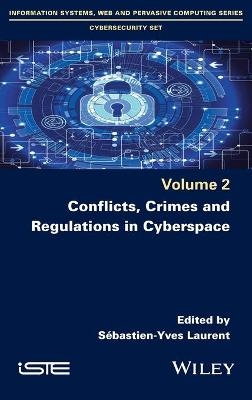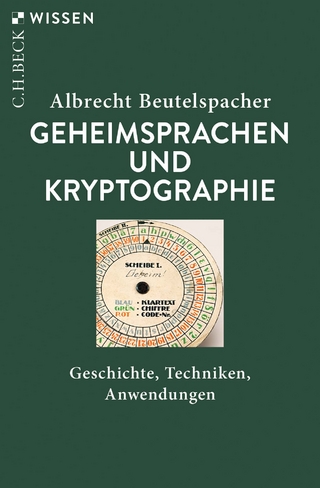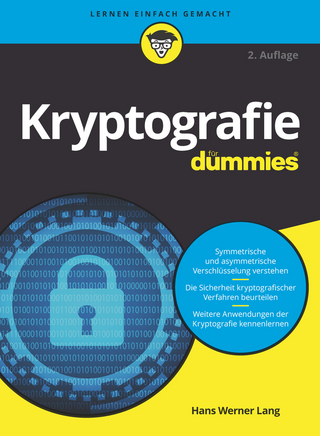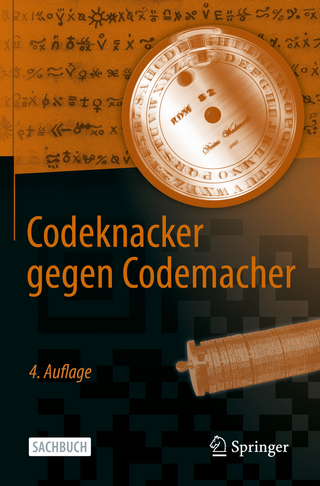
Conflicts, Crimes and Regulations in Cyberspace
ISTE Ltd and John Wiley & Sons Inc (Verlag)
978-1-78630-686-9 (ISBN)
This book presents cyberspace as a socio-technical system on an international level. It focuses on state and non-state actors, as well as the study of strategic concepts and norms. Unlike global studies, the socio-technical approach and “meso” scale facilitate the analysis of cyberspace in international relations. This is an area of both collaboration and conflict for which specific modes of regulation have appeared.
Sebastien-Yves Laurent is a Professor working in the Faculty of Law and Political Science at the University of Bordeaux, France. His research is in international relations and security studies, with a particular focus on cyber and digital issues.
Introduction Xi
Sébastien-Yves Laurent
Chapter 1 The United States, States And The False Claims Of The End Of The Global Internet 1
Sébastien-Yves Laurent
1.1 Introduction 1
1.2 The Creation Of The Internet And The Development Of Cyberspace By The United States 2
1.2.1 The First International Telecommunications Systems Developed By All States 3
1.2.2 The Creation And Development Of The Internet By The United States 3
1.2.3 International Management Controlled By The United States 4
1.2.4 A Sociotechnical System Bearing A Composite American Ideology 10
1.2.5 The False Recomposition Of The Global Sociotechnical System: The Global Summits On The Information Society 11
1.3 Cyberspace Transformed By The Arrival In Force Of States 13
1.3.1 State Intentions In “National Strategies”: A Global Approach 14
1.3.2 Russian–American Structural Disagreements On Information Security And Cybersecurity 16
1.3.3 Discussions On Cybersecurity: The Symbolic International Restoration Of The Coercive State 18
1.4 Praxis Of State Coercion In Cyberspace 20
1.4.1 Intelligence And Surveillance Activities In The Digital Environment 21
1.4.2 Non-Military Cyber Operations 24
1.4.3 Interstate Digital Conflicts, Secrecy And Coercive Diplomacy 26
1.5 The Fragmentation Of The Global Internet And The Digital Sovereignty Of States 29
1.5.1 Linguistic Balkanization: Digital Babel 29
1.5.2 Political Fragmentation: Alternative Internets 31
1.6 The Strong Constraint Of Interstate Cooperation For All States 33
1.6.1 Interstate Agreements On An Embryo Of International Law 33
1.6.2 State Dependence On International Cooperation For Cybersecurity 34
1.7 Conclusion 35
1.8 References 36
Chapter 2 Cybersecurity In America: The US National Security Apparatus And Cyber Conflict Management 43
Frédérick Gagnon and Alexis Rapin
2.1 Introduction 43
2.2 Societal And Institutional Dynamics 45
2.3 Organizational And Bureaucratic Dynamics 49
2.4 Individual Dynamics 53
2.5 Conclusion 57
2.6 References 58
Chapter 3 Separation Of Offensive And Defensive Functions: The Originality Of The French Cyberdefense Model Called Into Question? 63
Alix Desforges
3.1 Introduction 63
3.2 A Model Designed And Developed In Response To The Threats And Challenges Of The Early 2010s 66
3.2.1 An Organizational Model Apparently Based On Two Main Actors 66
3.2.2 The Commitment To A Strict Offensive/Defensive Separation 71
3.3 A Strict Separation Of Offensive And Defensive Functions And Missions: An Obstacle To Better Defense? 75
3.3.1 A Rapidly Changing Context: An Increasingly Significant Threat From The Most Advanced States 76
3.3.2 Limits That Have Become Obstacles To Accomplishing Cyberdefense Missions 78
3.3.3 An Institutionalized Rapprochement Of The Actors Of Defensive And Offensive Parts In The Name Of Cyberdefense Missions: From Mitigation To Obliteration? 82
3.4 Conclusion 85
3.5 References 86
Chapter 4 The Boundary Between Cybercrime And Cyberwar: An Uncertain No-Man’s Land 89
Marc Watin-Augouard
4.1 Introduction 89
4.2 The Field Of Cybercrime Up To The Limits Of The Glass Ceiling 91
4.2.1 The Field Of Cybercrime: An Attempt At Delimitation 92
4.2.2 Cybercrime, The “21st Century Crime” 95
4.2.3 Cyber Conflict At The Edge Of The Glass Ceiling 95
4.3 War In Cyberspace, Cyber In War 98
4.3.1 Cyber In War, A Daily Reality 98
4.3.2 Autonomous Warfare In The Cyber World: The Test Of The Law Of Armed Conflict 99
4.3.3 Digital Cyber Persuasion 102
4.4 Conclusion 104
4.5 References 105
Chapter 5 Cyberdefense, The Digital Dimension Of National Security 107
Bertrand Warusfel
5.1 Introduction 107
5.2 Cyberdefense In The Political And Legal Framework Of Digital Security 108
5.2.1 A Definition Of Cyberdefense 108
5.2.2 Linking Cyberdefense To National Security Strategy 109
5.3 The Emergence Of A Coherent Legal Regime For Cyberdefense 111
5.3.1 The Legal Basis Of The Permanent Cyberdefense Posture 111
5.3.2 Exceptional Instruments For Responding To A Crisis 112
5.4 Conclusion 115
5.5 References 116
Chapter 6 Omnipresence Without Omnipotence: The US Campaign Against Huawei In The 5G Era 117
Mark Corcoral
6.1 Introduction 117
6.2 The Unilateral American Offensive Against Huawei: A Disruptive Campaign Causing Significant Collateral Damage 119
6.2.1 Huawei: An “Unusual And Extraordinary” Threat To The United States’ Position In The International Order 120
6.2.2 A Political, Legal And Economic Offensive Against Huawei, Causing Significant Collateral Damage 122
6.3 The American Diplomatic Offensive: The Limits Of American Rhetorical Coercion Of Their Partners And Allies 128
6.3.1 Educating Rather Than Persuading: An Attempt To Rhetorically Coerce Partners And Allies 129
6.3.2 Successful Agenda Setting But Limited Rhetorical Coercion 131
6.3.3 American Rhetorical Coercion In The Special Relationship 134
6.4 The Anti-Huawei Offensive: A Barometer Of American Power? 137
6.5 References 139
Chapter 7 The Issue Of Personal And Sovereign Data In The Light Of An Emerging “International Law Of Intelligence” 147
Fabien Lafouasse
7.1 Introduction 147
7.2 The Legal Rules Invoked In The Collection Of Personal And Sovereign Data 150
7.2.1 Right To Privacy Versus General Communications Surveillance 150
7.2.2 Violation Of Territorial Sovereignty Versus Cyberespionage 153
7.3 Data Localization In The Light Of International Intelligence Law 156
7.3.1 Data Fluidity Versus Data Storage 156
7.3.2 Datasphere Versus International Intelligence Law 159
7.4 Conclusion 163
7.5 Appendix: The Quadrants Of Intelligence Law 164
7.6 Sources And References 165
7.6.1 Sources 165
7.6.2 References 166
Chapter 8 International Cybersecurity Cooperation 169
Guillaume Poupard
8.1 Current Attack Trends 169
8.2 The Multiple Paths Of International Cooperation 171
8.3 The Issue Of Attack Attribution 175
Chapter 9 Cyberdefense And Cybersecurity Regulations In The United States: From The Failure Of The “Comprehensive Policy” To The Success Of The Sectoral Approach 177
Adrien Manniez
9.1 Introduction 177
9.2 The Identification Of A New Threat And The Impact Of Cyber On How US Security And Defense Policies Are Designed 178
9.3 From The Impact Of Cyber On Policy To The Impact Of Politics On Cyber 181
9.4 From A Comprehensive Cyber Policy To A Sectoral Approach: The Success Of An Undeclared Regulatory Policy 190
9.5 Conclusion 195
9.6 References 196
List of Authors 199
Index 201
| Erscheinungsdatum | 18.01.2022 |
|---|---|
| Verlagsort | London |
| Sprache | englisch |
| Maße | 10 x 10 mm |
| Gewicht | 454 g |
| Themenwelt | Informatik ► Theorie / Studium ► Kryptologie |
| ISBN-10 | 1-78630-686-7 / 1786306867 |
| ISBN-13 | 978-1-78630-686-9 / 9781786306869 |
| Zustand | Neuware |
| Haben Sie eine Frage zum Produkt? |
aus dem Bereich


